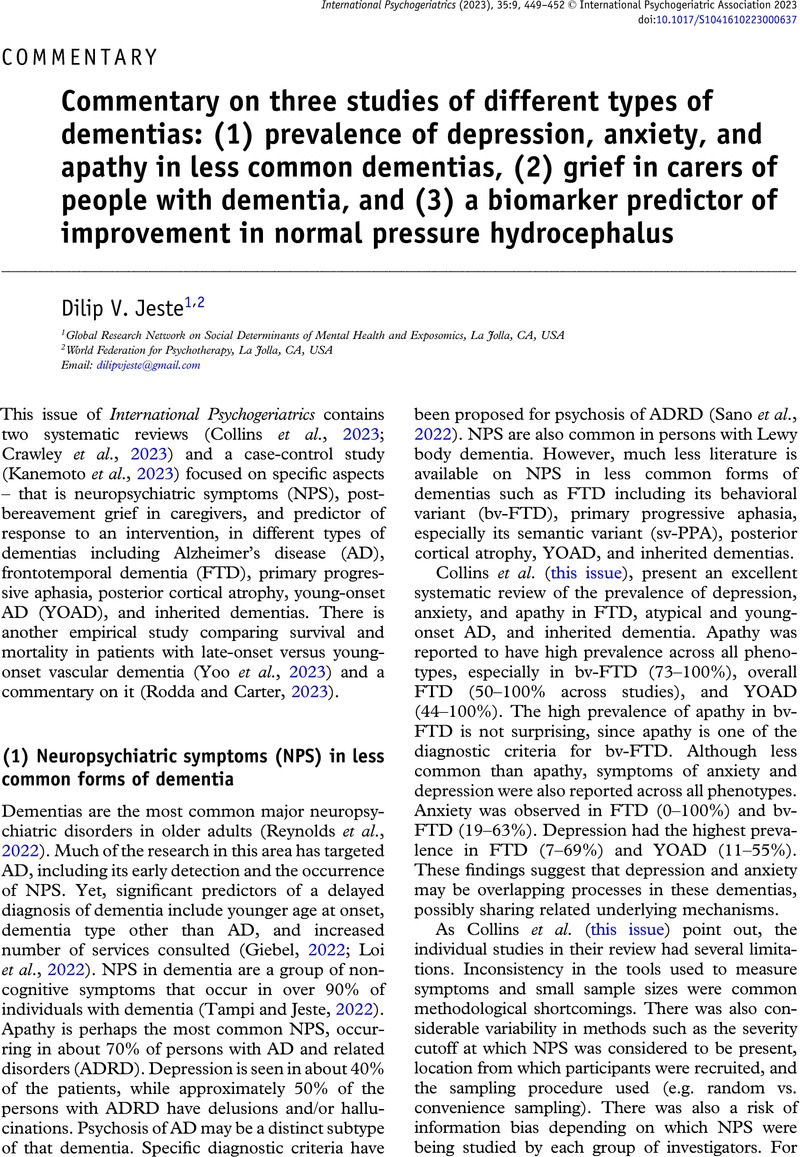No CrossRef data available.
Article contents
Commentary on three studies of different types of dementias: (1) prevalence of depression, anxiety, and apathy in less common dementias, (2) grief in carers of people with dementia, and (3) a biomarker predictor of improvement in normal pressure hydrocephalus
Published online by Cambridge University Press: 29 August 2023
Abstract
An abstract is not available for this content so a preview has been provided. Please use the Get access link above for information on how to access this content.

- Type
- Commentary
- Information
- International Psychogeriatrics , Volume 35 , Special Issue 9: Issue Theme: Studies of Different Types of Dementias , September 2023 , pp. 449 - 452
- Copyright
- © International Psychogeriatric Association 2023
References
American Psychiatric Association (2022). Diagnostic and Statistical Manual of Mental Disorders, 5th edition, Text Revision (DSM-5-TR). Washington, DC: American Psychiatric Association.Google Scholar
Collins, J. D., Henley, S. M. D. and Suarez-Gonzalez, A. (2023). A systematic review of the prevalence of depression, anxiety and apathy in frontotemporal dementia, atypical and young-onset Alzheimer’s disease and inherited dementia. International Psychogeriatrics, 35, 457–476.Google Scholar
Crawley, S., Sampson, E. L., Moore, K. J., Kupeli, N. and West, E. (2023). Grief in family carers of people living with dementia: a systematic review. International Psychogeriatrics, 35, 477–508.Google Scholar
Giebel, C. (2022). Young-onset dementia and its difficulties in diagnosis and care. International Psychogeriatrics, 34, 315–317. https://doi.org/10.1017/S1041610220003452.CrossRefGoogle ScholarPubMed
Josefowitz, N. (2013). Living Without the One You Cannot Live Without: Hope and Healing after Loss. CreateSpace Publishing.Google Scholar
Kanemoto, H., et al. (2023). Cerebrospinal fluid amyloid beta and response of cognition to a tap test in idiopathic normal pressure hydrocephalus: a case-control study. International Psychogeriatrics, 35, 509–517.Google Scholar
Loi, S., et al. (2022). Time to diagnosis in younger-onset dementia and the impact of a specialist diagnostic service. International Psychogeriatrics, 34, 367–375. https://doi.org/10.1017/S1041610220001489.CrossRefGoogle ScholarPubMed
Micchia, K., et al. (2022). Normal pressure hydrocephalus: neurophysiological and neuropsychological aspects: a narrative review. Medicine (Baltimore), 101, e28922. https://doi.org/10.1097/MD.0000000000028922.CrossRefGoogle ScholarPubMed
Passos-Neto, C. E. B., Lopes, C. C. B., Teixeira, M. S., Studart Neto, A. and Spera, R. R. (2022). Normal pressure hydrocephalus: an update. Arquivos de Neuro-Psiquiatria, 80, 42–52. https://doi.org/10.1590/0004-282X-ANP-2022-S118.CrossRefGoogle ScholarPubMed
Reynolds, C. F., Jeste, D. V., Sachdev, P. and Blazer, D. G. (2022). Mental health care for older adults: recent advances and new directions in clinical practice and research. World Psychiatry, 21, 336–363. https://doi.org/10.1002/wps.20996.CrossRefGoogle ScholarPubMed
Reynolds, C. F. III (editors), (2023). Grief and Prolonged Grief Disorder. Washington, DC: American Psychiatric Association Publishing.Google Scholar
Rodda, J. and Carter, J. (2023). Highlighting the need for better care planning in young onset dementia. Commentary on ‘Comparing survival and mortality in patients with late-onset and young-onset vascular dementia’ by Yoo et al. International Psychogeriatrics, 35, 453–455.Google Scholar
Sano, M., Cummings, J., Jeste, D. V., Finkel, S. and Reichman, W. (2022). Select International Psychogeriatric Association (IPA) consensus for defining psychosis in major and mild neurocognitive disorders. International Psychogeriatrics, 34, 203–207. https://doi.org/10.1017/S1041610221000260.CrossRefGoogle Scholar
Shprecher, D., Schwalb, J. and Kurlan, R. (2008). Normal pressure hydrocephalus: diagnosis and treatment. Current Neurology and Neuroscience Reports, 8, 371–376. https://doi.org/10.1007/s11910-008-0058-2.CrossRefGoogle ScholarPubMed
Smagula, S., et al. (2023). Activity patterns related to depression symptoms in stressed dementia caregivers. International Psychogeriatrics, 35, 373–380. https://doi.org/10.1017/S1041610219001601.CrossRefGoogle ScholarPubMed
Tampi, R. and Jeste, D. V. (2022). Dementia is more than memory loss: neuropsychiatric symptoms of dementia and their non-pharmacological and pharmacological management. American Journal of Psychiatry, 179, 528–543. https://doi.org/10.1176/appi.ajp.20220508.CrossRefGoogle Scholar
Wang, S., et al. (2022). Postoperative delirium and its relationship with biomarkers for dementia: a meta-analysis. International Psychogeriatrics, 34, 377–390. https://doi.org/10.1017/S104161022100274X.CrossRefGoogle Scholar
Yoo, M., et al. (2023). Comparing survival and mortality in patients with late-onset and young-onset vascular dementia. International Psychogeriatrics, 35, 519–527.Google Scholar




